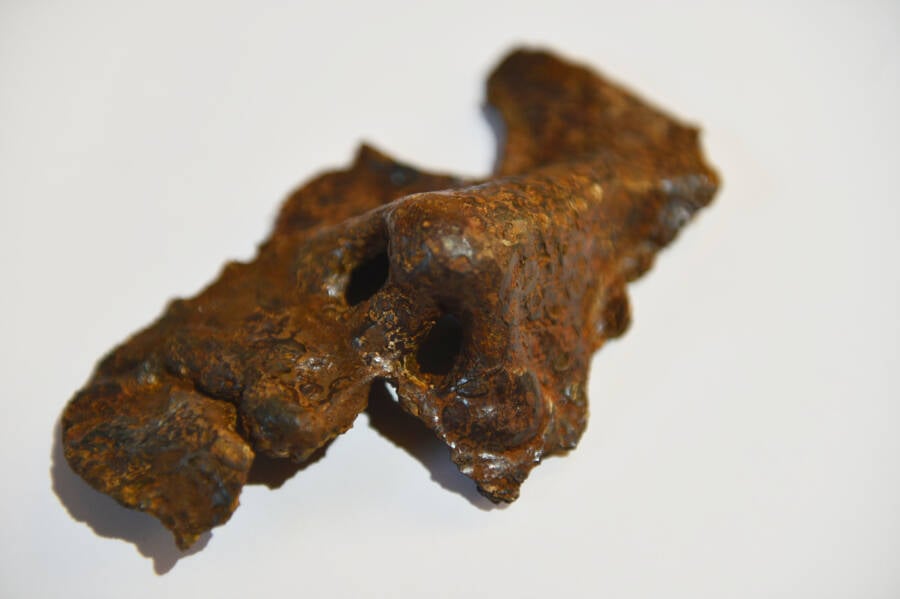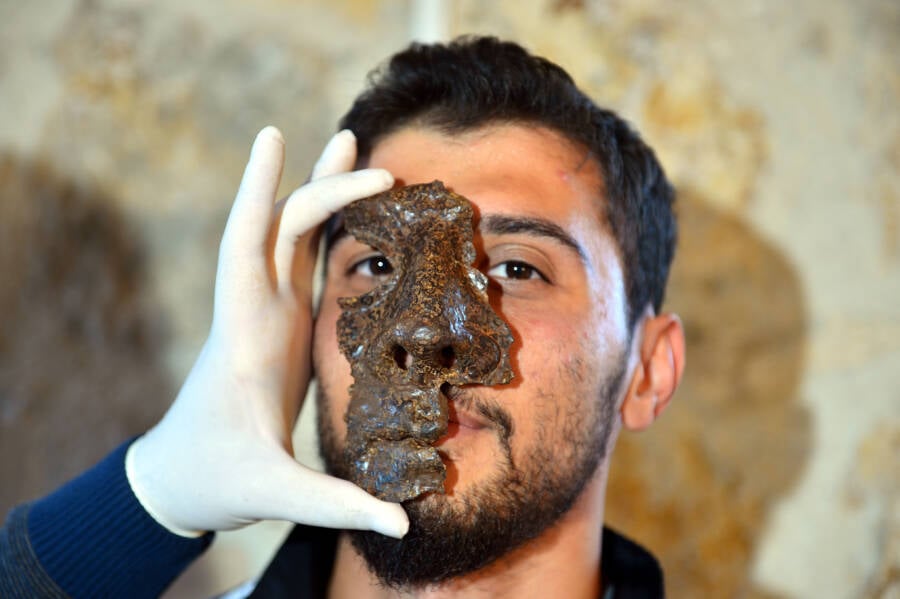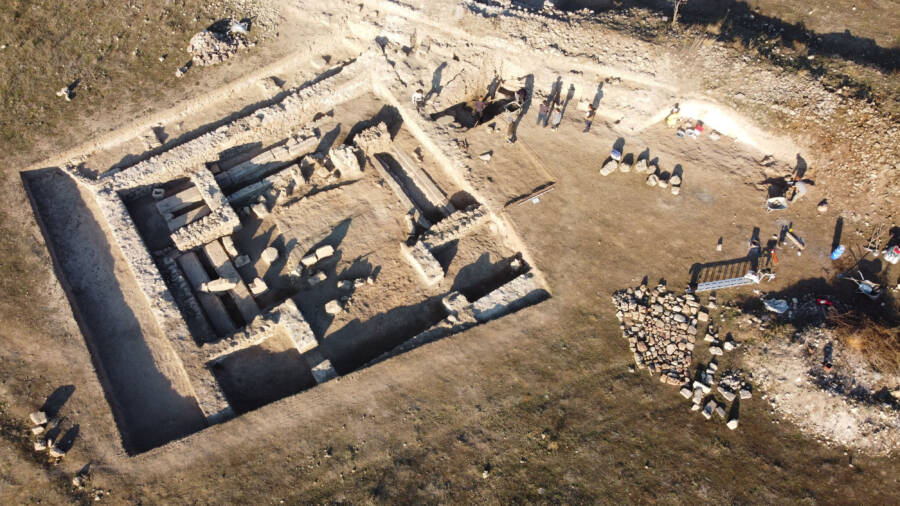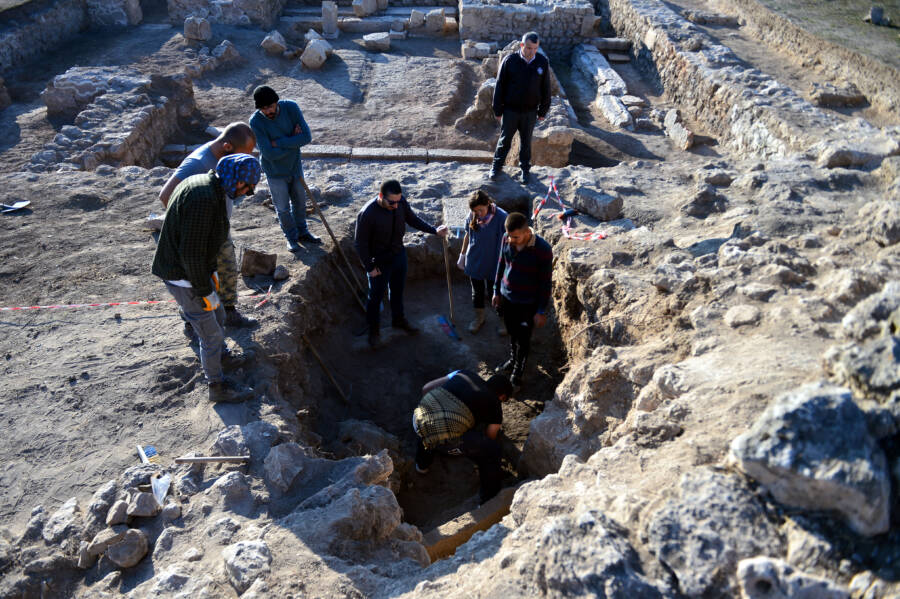The iron face mask was found among remnants of a fortified structure dated to Ancient Rome's imperial period. It firmly suggested Hadrianopolis was an important, distant military outpost.

Ahmet Ozler/Anadolu Agency/Getty ImagesThe Roman face mask was dated to the early third century A.D.
Named after Roman emperor Hadrian, it’s no wonder that the ancient city of Hadrianopolis has become a treasure trove of Roman relics. While archaeologists have found invaluable remnants there before, they’ve just unearthed an 1,800-year-old face mask made of iron — that was once worn by a Roman cavalry soldier.
The excavation site itself is located near Paphlagonia in the northern Karabük province’s Eskipazar district. While this was at the far reaches of the Roman Empire, archaeological digs that have been ongoing since 2003 have already yielded about 14 structures suggesting Hadrianopolus once served as a military outpost.
According to Ancient Origins, the iron mask unearthed by Karabük University researchers only furthered that notion. Dated to the early third century A.D., it was discovered among remnants of an ancient fortified structure that experts believe was a Roman garrison.
“The military presence of the Romans in this inner geography of the Western Black Sea was unknown,” lead archaeologist Ersin Çelikbas said. “But it is most likely that the Roman Empire established a military base here in order to obtain a frontal defense area against all kinds of dangers from the east and the Black Sea.”
“Therefore, we can say that Hadrianapolis was one of the important defense cities of Rome.”

Ahmet Ozler/Anadolu Agency/Getty ImagesThe mask was found among remnants of a fortified structure that experts believe was a military base.
Also known as Caesarea or Proseilemmene, Hadrianopolis was inhabited from the first century B.C. to the eighth century A.D. According to The Daily Mail, experts have found two baths, two churches, a theater, rock tombs, a city square, one villa, a niche once housing a monument, and a fortified building here since 2003.
“We continued the excavation of what we call a square planned structure for six months,” Çelikbas told The Hürriyet Daily News. “Although we cannot identify the function of this structure, we have obtained some information to make some predictions. It indicates that this square building was a military building.”
“We also found small pieces, such as the iron mask. The iron mask was an accessory worn by Roman cavalrymen to protect their faces. It is from 1,800 years ago.”
Çelikbas explained that he and his peers dated the mask to the third century A.D. by comparing it to similar masks found elsewhere. Its discovery in a fortified structure from Rome’s imperial period also suggested as much. As for Hadrianopolis itself, Çelikbas believed it was of the utmost strategic importance to the Romans.

Ahmet Ozler/Anadolu Agency/Getty ImagesExcavations at Hadrianopolis have been ongoing since 2003.
“Rome planned to make its defense at the far end [of its empire] by building bases against all kinds of dangers that may come from the Black Sea Region to its territory,” said Çelikbas. “We think Hadrianopolis is one of these defensive military cities.”
Hadrianopolis also yielded a litany of Roman Christian floor mosaics in the last year. From depictions of horses and elephants to panthers, deer, and griffins, the artistic finds have given Hadrianopolis the unofficial title of “Zeugma of the Black Sea.”
Ancient Anatolia had essentially become a conflagration of independent kingdoms by the second century B.C., with modern-day Istanbul (then Byzantium) an integral city for the Roman Empire’s distant influence. And apparently, ancient texts support the idea of Hadrianopolis hosting a military base.
“The history of the inner regions of the Western Black Sea Region has not been fully elucidated yet,” said Çelikbas. “We continue to illuminate the history of the region with our studies. During our excavations, we reached important data showing the existence of the Roman Empire in the region.”

Ahmet Ozler/Anadolu Agency/Getty ImagesA snapshot of archaeological work at Hadrianopolis in late November.
Remarkably, the face mask was only found after officials fought to boost tourism. After the discovery of mosaics last year, Turkey’s Ministry of Culture and Tourism petitioned for Hadrianopolis to be “transformed into ruins and opened to tourism” — leading to renewed excavations by 43 experts and academics.
Excavations at Hadrianopolis will remain ongoing for the time being. Smaller relics unearthed at the site will be safely secured in regional museums while the heftier finds will be protected and preserved where they stand. Hopefully, Çelikbas and his peers continue to find stunning remnants from a civilization long gone.
After reading about the 1800-year-old Roman face mask found in Turkey, learn about the Roman-era workshops unearthed in Turkey. Then, read about the 2000-year-old Roman sewer system uncovered in Turkey.





